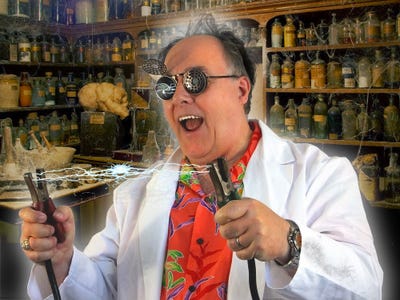Turn Components and Circuit Boards Into Art
What’s not to love about electronic art, from components to PCBs?
May 16, 2024

At a Glance
- One way to create art is to take old circuit boards, remove any components, cut them into desired shapes, & backlight them.
- Another route is to solder electronic components together to form representations of animals, machines, countries, etc.
I have a friend. It’s true. I’ll wait for you to stop laughing and then we’ll continue … thank you so much. Let’s start again. I have a friend called Paul who is based in the UK.
Are you familiar with Nixie tubes? They were all the rage when it came to displaying digital information in the 1950s, 1960s, and 1970s. I love them. Well, deep in the mists of time, Paul built a Nixie tube clock. He intended it for himself, but the first person to see it wanted to buy it, so Paul sold that one and built another.
This second clock also sold quickly. Before Paul knew it, he had a full-fledged business designing the most awesome Nixie tube clocks under the auspices of his company, Bad Dog Designs.
Whenever I return to England to visit my dear old mom, on the last Friday before I return to the USA, a sprocket of my techno-geek friends flock from all over the UK to visit me at my brother’s house in Sheffield (where “sprocket” is the collective noun for a group of engineers or, if it isn’t, it should be). We spend the day showing off our latest and greatest creations. The reason I mention this here is that Paul is a charter member of our geeky group.
Once, we were joined by Dalibor Farny, who hails from the Czech Republic. The reason Dalibor’s name appears here is that major manufacturers stopped producing Nixie Tubes in the late 1980s. The way most people get Nixie tubes today is by reclaiming them from old test equipment or as new old stock (NOS) from Eastern Europe (and Russia before Putin went rogue), where NOS refers to aged stock of merchandise that was never sold to a customer and still new in original packaging. Having said this, Dalibor has built a worldwide clientele for his gorgeous, handcrafted 2 in. wide by 4 in. tall Nixie tubes.
Returning to Paul, he once brought one of his Bombe clocks to our show-and-tell. This clock features six of Dalibor’s Nixies (it’s like the circle of life). All I can say is that I drool with desire whenever I see this bodacious beauty below (the clock, not Paul).
Paul has also been a regular contributor to the Money For Nothing television series in the UK. As we read on the Wikipedia: “The premise of the program is to take items that other people have disposed of and which the presenter rescues from council refuse collection sites. With the help of a designer, they are turned into desirable items, which are then sold. Any profit made is then returned to the individual(s) who disposed of the item originally.”
So, why am I waffling about Paul here? Well, earlier today I received an email from a Design News community member who had run across one of my old columns asking whether Paul was still making his Map of the World clocks featuring recycled printed circuit boards (PCBs).

Map of the World Clock. PAUL PARRY
I like to flatter myself that I have a creative streak, but I realize how far I fall short when I see the awesome artifacts my friends come up with. I’d forgotten all about Paul’s Map of the World constructions until I received the aforementioned email. Now I’m back to wanting to build one of these myself (even though the last thing I need is another hobby project).
I have no idea why the guy who emailed me didn’t contact Paul directly, but I’ve learned not to ask questions, so I pinged Paul. It turns out he’s placed his Map of the World clocks on the back burner because he’s started a new line of Electronic Component-Based Art. For example, Paul’s interpretation of a Star Wars’ Death Star is shown below.

Electronic component-based art: Death Star. PAUL PARRY
Paul uses these techniques to create representations of all sorts of things, from animals like a Golden Retriever to machines like a Spitfire to countries like Italy and the United Kingdom. The image below shows a close-up of one of Paul’s United Kingdom pieces.

Electronic component-based art: United Kingdom. PAUL PARRY
Paul also sent me images of his latest work-in-progress, which is a component-based representation of the entire map of the world, but I will wait until that’s finished before sharing anything.
It seems I’m not the only one who is enamored with this sort of thing. Paul tells me that people are approaching him for custom pieces and companies are requesting him to do the same treatment for their logos.
O-M-G! I just now saw Paul’s interpretation of Doctor Who’s TARDIS. I LOVE Doctor Who. I’ve been watching it since the first episode on 23 November 1963 (I was only six years old, and I watched it from behind the safety of the sofa). I meet with a group of friends to watch Doctor Who on Tuesday Evenings. All I can say is, “I have to make me one of these!”
What say you? Having seen Paul’s electronic component-based art, are you tempted to create something like this yourself? As always, I welcome your comments, questions, and suggestions. Please feel free to email me at [email protected].
About the Author(s)
You May Also Like





